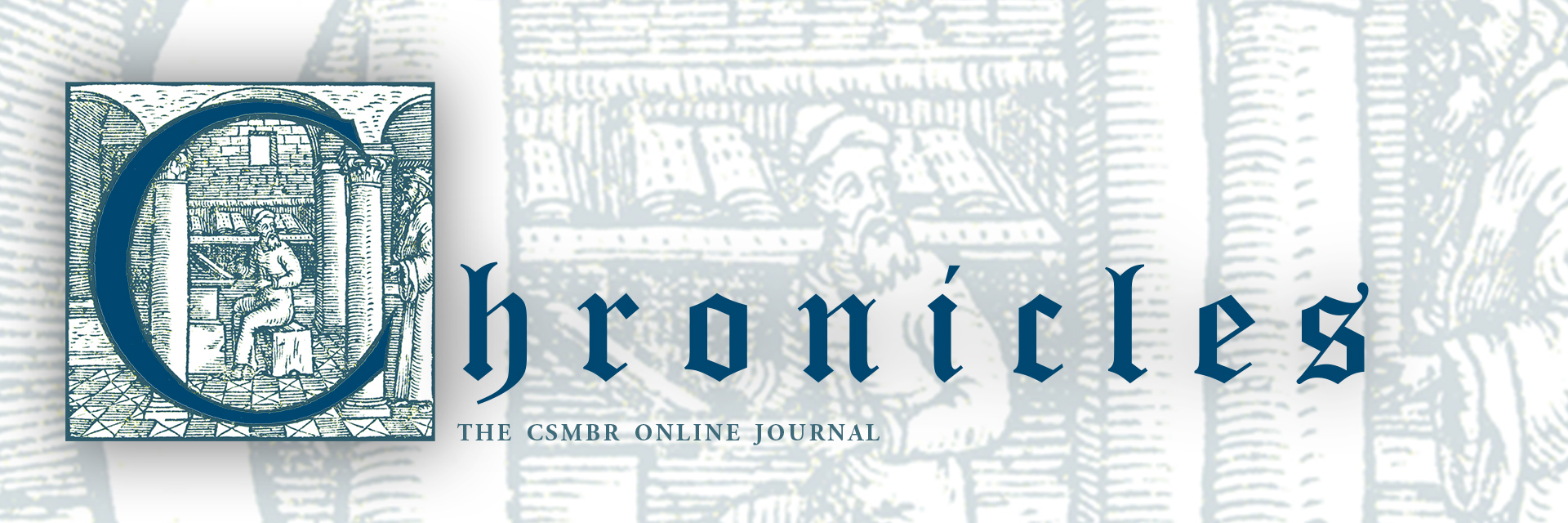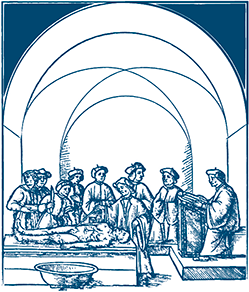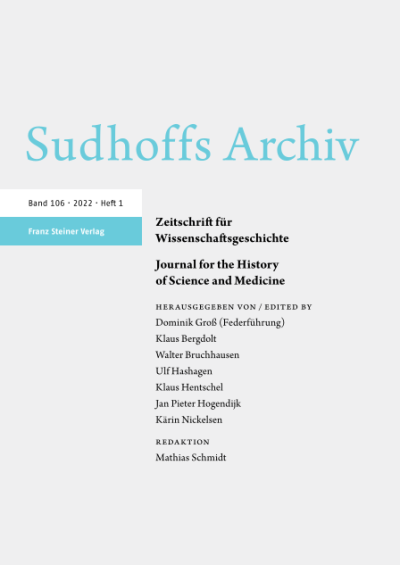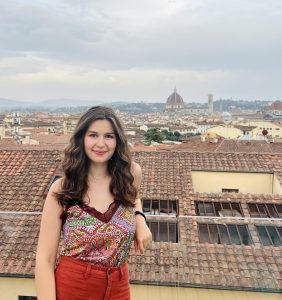Chronicles is the online journal of the CSMBR Community where you can find the latest news about our fellows’ activities, including book publications, conferences, colloquia, grants, interviews and much more.

Latest Conferences
An Italian conference on the Ethics of Food and Nutrition in the Early Modern Period to be held in Rome (29 January 2024).
New Titles in the PSMEMM Series
This edited volume explores the intersection of medicine and philosophy throughout history, calling attention to the role of quantification in understanding the medical body. To check the title’s content and chapters, click on the cover.
Resulting from the Santorio Award 2022, this book offers the first extensive and interdisciplinary treatment of the theory of genetic inheritance across the fields of history, philosophy, and theology. To check the title’s content and chapters, click on the cover.
New Networks
Dr Fabrizio Bigotti, director of the CSMBR, is appointed co-editor of the prestigious and historical Journal Sudhoffs Archiv, the oldest running academic journal in the history of medicine and science.
Lecture Series
The Journal Aristotelica organises a series of lectures on the Early Modern development of Aristotle’s scientific terminology.
Upcoming Conferences
An international conference on the occasion of Pliny the Elder’s bimillenary (23-2023) held in Lisbon.
Check our Latest Publications
Click on the image and check the forthcoming volumes in the series
VivaMente Pubblications
Supported by the VivaMente Grant awarded in 2020 to Mr. Baldassarri, the book offers some new contributions to the field of Cartesian medicine. Available for pre-order here
Meet the Fellow
At the end of an intense four-day event, Prof. Alexander Marr (University of Cambridge) reflects on his experience as keynote speaker of the 2023 Summer School and on the intellectual and social environment he found at CSMBR. Enjoy! 2023 Summer School and on the intellectual and social environment he found at CSMBR. Enjoy!
Latest from the CSMBR Community
Intersecting Paths: Nephele and Daniel on the Convergence of Medicine, Law, and History
A Deep Dive into the VivaMente Grant-Funded Conference 2024

Nephele Papakonstantinou
Congratulations on being awarded the VivaMente Grant for your upcoming conference. Can you tell us about the inspiration behind “Narratio in Medicine and the Law”?
Nephele: Thank you! The inspiration really stemmed from our individual research projects—mine in legal medicine and Daniel’s in diagnosis. We noticed a fascinating intersection between rhetoric and factual evidence in medical and medico-legal case histories. This conference aims to explore those intersections across various eras.
What specific goals do you have for this conference?
Daniel: Our main goal is to reassess the historical evolution of case histories or consilia as a specific literary form of medical and medico-legal writing, particularly focusing on its role in justice administration. We’re excited to delve into new questions and contribute to the ongoing debate in this field.
The conference covers a wide range of eras. How did you decide on this broad scope?
Nephele: We wanted to highlight the continuity and transformation of medical and medico-legal narratives from Graeco-Roman Antiquity, through Medieval Islamic medicine, to the Renaissance. This wide scope allows us to compare and contrast different cultural approaches to medical truths and their legal interactions.
It sounds like a highly interdisciplinary event. What do you hope to achieve by bringing together specialists from various fields?
Daniel: By drawing on the expertise of specialists in Classics, legal history, history of medicine, and the sciences, we aim to foster a rich, interdisciplinary dialogue. We believe this will offer new insights into how medical truths were shared and communicated across cultures and times, especially in relation to the law.

Daniel King
How will the VivaMente Grant facilitate this conference?
Nephele: The grant has been instrumental in enabling us to chart the development of medical case-histories and their interactions with medico-legal narratives. It’s allowed us to invite distinguished experts and attract early-career scholars from around the world, making it a truly international and interdisciplinary event.
What are you most looking forward to at the conference?
Daniel: Beyond the academic exchange, we’re looking forward to fostering new collaborations and networks. The field is ripe with exciting work, and we anticipate that this conference will spark innovative research directions and methodologies.
Lastly, any message for the participants and the wider academic community?
Nephele: We encourage everyone interested in the intersections of medicine, law, and literature to join us. This conference is not just about revisiting historical case-histories; it’s about envisioning new ways to understand the narratives that shape medical and legal practices today.
Thank you both for sharing your insights. We wish you a successful and enriching conference.
Daniel: Thank you! We’re looking forward to an engaging and thought-provoking event.
Latest Collaborations
Exploring Collaborative Visions and Academic Excellence
Dr. Viktorya Vasilyan comments on the recent new strategic collaboration between the CSMBR and the Institute of Archaeology and Ethnography NAS RA of the Armenian Academy of Sciences and how passion and purpose can chart a road ahead in academic synergy.
Viktorya, thank you for joining us today. Let’s start by discussing the collaboration between the Institute of Archaeology and Ethnography (IAE) and the Centre. Can you tell us about your institution and the type of research you conduct there?
Of course. The Institute of Archaeology and Ethnography is a vital institution within the National Academy of the Republic of Armenia. We focus on scientific programs primarily in the fields of archaeology, ethnology, and folkloristics. With a team of around two hundred specialists, we produce a substantial volume of scholarly work every year, including articles, conference proceedings, books, and other scientific materials. Additionally, we regularly host conferences, seminars, dissertation defenses, and various scientific events to disseminate and discuss our research results. People interested in our activities can find more about our work on our website (https://iae.am/en) or follow us on Facebook (https://www.facebook.com/iaenasr).
That sounds like an impressive range of activities and research. What’s your role in this institution?
At present, I’m heading the Scientific Organizational Department at the Institute. I’m particularly excited about our ongoing “100 Archaeological Monuments Project,” a collaboration between our institute and the American University of Armenia (AUA). Furthermore, I co-teach the “Introduction to Archaeology” course at AUA alongside Professor Arsen Bobokyan, who also serves as the Director of the Institute of Archaeology and Ethnography. You can find more information about this collaboration on the project website (https://ama100.am/en) and the AUA website (https://aua.am/).
Now, regarding your collaboration with the CSMBR, what do you expect from this partnership?
We are genuinely excited about collaborating with the CSMBR across various educational and research domains. Together, we believe we can develop common scientific initiatives, such as workshops, conferences, and even archaeological excavations, to further advance our understanding of these fields. We envision an active exchange of programs between our students and staff, which will enrich the educational experiences of both institutions. Additionally, we anticipate collaborating on various scientific and educational activities, grants, seminars, and more.
It’s clear that there are many exciting prospects for collaboration. Could you elaborate on why you specifically chose the CSMBR for this partnership?
Well…I hold a personal connection to CSMBR since at least 2019, as I’ve been actively participating in different summer schools and online lectures organized by the center. During these interactions, I was deeply impressed by the values of humanism, kindness, and solidarity that the CSMBR embodies towards every group member. I genuinely appreciate these qualities, and they have made a lasting impression on me. The CSMBR is not only an international research center it is also a highly reputed institution. Its commitment to making a real difference for a sustainable future aligns perfectly with our aspirations. The CSMBR’s holistic approach, integrating research, education, and outreach, strengthens the excellence of its disciplines and fosters cross-disciplinary actions, which are in line with our goals.
Looking ahead, what are your expectations for this collaboration in the future?
In the future, we hope to cultivate a highly productive and mutually beneficial collaboration between our two institutions. We envision organizing various conferences and participating in grants related to digital humanities and anthropology. Moreover, interdisciplinary research in the history of humanities is an exciting prospect that we’d like to explore further. Ultimately, we aim to foster a vibrant academic exchange that transcends borders and disciplines, contributing to the enrichment of knowledge and the advancement of research in our respective fields.
Thank you, Viktorya. We look forward to witnessing the fruitful outcomes of this partnership in the years to come.
Hopefully, this will be the beginning of a highly productive and mutually beneficial collaboration between us. Thank you for this great opportunity and for the many that will come with it.
Meet the Fellow
Whispers of Italy. A Journey into Monastic Healing Traditions
2023 Santorio Global Fellow Madeleine Sheahan will be spending three months at the University of Parma researching on women’s medicine in Italian monasteries. We met her and discussed her project.
Madeleine, first of all congratulations on awarding the Fellowship. What does it feel like to be the first Santorio Global Fellow?
Well, it’s very gratifying, particularly because my project falls outside of the traditional bounds of early modern intellectual history. Not only does the project focus on the intellectual and social history of women whose stories are often ignored by the historical record, but it also specifically centers the practices of everyday women rather than exceptional, elite female practitioners. Being awarded the fellowship thus shows how these themes are becoming increasingly recognized in the field. It is a point of personal and professional pride to have the opportunity to participate in continued efforts to broaden the historical understanding of women’s involvement in medicine and science.
Tell us about yourself: your studies, your interests.
I am a Ph.D. student in the program for the History of Science and Medicine at Yale University. My research examines the social and intellectual history of female medical practice in sixteenth and seventeenth-century Italy. I am particularly interested in the relationship between pharmacology and cookery, with a focus on the commercial activities of religious women who prepared and sold medicines alongside other edible wares such as confections and pastries.
I am originally from Toronto, Canada, where I earned my B.A. in Renaissance Studies and my M.A. in the History of Science and Technology at the University of Toronto. In my free time, I pursue many crafts, including drawing, painting, sewing, and baking. My interests in pharmacology and food history have guided much of my baking, inspiring me to experiment with historical techniques and recipes. I continue to test new and old recipes, sharing my creations with friends and family!
What’s your project about? Why do you think it is important to research it?
My project will form a central chapter of my Ph.D. dissertation and investigates the medical expertise of monastic women in northern Italy between the sixteenth and seventeenth centuries. My research emphasizes socio-spatial patterns of early modern medical care and knowledge production by considering the work of monastic women in urban, semi-rural, and rural geographies. I will conduct this research primarily in Parma, sponsored by the University of Parma, which offers me an ideal location from which to investigate local and regional practices in relation to larger urban centers such as Bologna and Milan.
By integrating the health-related activities of religious women in villages, towns, and the countryside into a larger history of convent pharmacy in early modern Italy, my study will demonstrate the extensive scope and importance of female monastic medicine across multiple geographies. This research is thus important because it complicates histories of pharmacy that have privileged the participation of urban men, and more recently urban women, above the intellectual pursuits and medical skills of rural female practitioners.
What are your sources, what do you expect from your research in Parma?
My sources are predominantly institutional records of a range of female monasteries that owned and operated public pharmacies in the region of Emilia-Romagna. Given the often-obscure nature of documentary material related to monastic businesses, my project depends on sources like administrative records, financial documents, and correspondences to elucidate signs of pharmacy-related activities. More explicit sources include business records, records of medicinal ingredients and stores, recipes books, and instruction manuals. In conversation with each other, I expect these sources will speak to the broader social, economic, and intellectual culture of female monastic institutions and highlight specific and localized practices related to making and selling medicines.
What motivated you to apply for a Santorio Global Fellowship?
I was motivated to apply for the Santorio Global Fellowship because it offered an opportunity not only to pursue my research, but also to join an international community of scholars. The possibilities of engaging with diverse members from both the CSMBR and the University of Parma greatly appealed to me. Because I firmly believe the best scholarship is born from collaboration and generosity, I was eager to apply for a fellowship that would intentionally foster that sense of intellectual community.
How did you hear about the CSMBR?
I first heard about the CSMBR when a faculty member in my home department at Yale circulated news of the Center’s summer school programing. Though I was unable to attend, I became aware of the CSMBR’s extensive programing and support for early-stage Ph.D. students. The focus of the Center naturally complimented many of the themes most relevant to my research in the history of early modern medicine, which encouraged me find other opportunities to engage with the CSMBR.
What's going on our social media?
𝐂𝐒𝐌𝐁𝐑 𝐎𝐍𝐋𝐈𝐍𝐄 𝐋𝐄𝐂𝐓𝐔𝐑𝐄 𝐒𝐄𝐑𝐈𝐄𝐒 Glad to share the latest lecture in our series. This talk by Tawrin Baker examines several late sixteenth-century anatomical works that
Analysis and Synthesis in Sixteenth-Century Anatomy - T. Baker (Independent)
The term “anatomy” in the early modern period was multifaceted, and at times it was explicitly understood via the Greek terms "analysis" and "synthesis" or t...
Reminder
𝐌𝐄𝐃𝐈𝐂𝐈𝐍𝐄 𝐀𝐍𝐃 𝐓𝐇𝐄 𝐍𝐄𝐀𝐏𝐎𝐋𝐈𝐓𝐀𝐍 𝐏𝐋𝐀𝐆𝐔𝐄 𝐎𝐅 𝟏𝟔𝟓𝟔
𝐍𝐞𝐰 𝐃𝐨𝐜𝐮𝐦𝐞𝐧𝐭𝐬 𝐚𝐧𝐝 𝐏𝐞𝐫𝐬𝐩𝐞𝐜𝐭𝐢𝐯𝐞𝐬
𝐒𝐢𝐥𝐯𝐚𝐧𝐚 𝐃'𝐀𝐥𝐞𝐬𝐬𝐢𝐨
14 May 2024 – 5 PM (CEST)
To register for this event:
Medicine and the Neapolitan Plague of 1656 - CSMBR
This lecture explores a variety of little know sources on the Neapolitian plague of 1656, offering new documents and perspectives on its unfolding and they way physicians tried to cope with it.





















